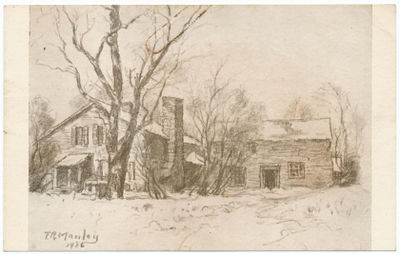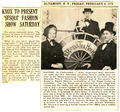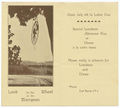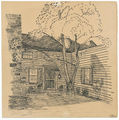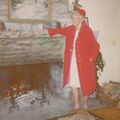Difference between revisions of "Merrymen's Tea House"
JElberfeld (talk | contribs) m |
JElberfeld (talk | contribs) m (Text replace - "Altamont Enterprise" to "Altamont Enterprise") |
||
| Line 128: | Line 128: | ||
== TEA HOUSE BURNS == | == TEA HOUSE BURNS == | ||
| − | The [[Altamont Enterprise]] N. Y., Friday, November 18, 1949 | + | The [[h:Altamont Enterprise|Altamont Enterprise]] N. Y., Friday, November 18, 1949 |
Merrymen's Tea House has burned to the ground, a total loss to the owner of building and contents. The total loss was through no fault of the firemen, but because Knox has no fire equipment. It has no truck, no hose; no masks, no ladders. A fire must have water at once at start of the fire in order to have effect. By the time neighboring equipment has arrived it is too late to stop the original fire. It can be checked and the neighboring houses and barns saved, but the original fire cannot be put out. It is too late. | Merrymen's Tea House has burned to the ground, a total loss to the owner of building and contents. The total loss was through no fault of the firemen, but because Knox has no fire equipment. It has no truck, no hose; no masks, no ladders. A fire must have water at once at start of the fire in order to have effect. By the time neighboring equipment has arrived it is too late to stop the original fire. It can be checked and the neighboring houses and barns saved, but the original fire cannot be put out. It is too late. | ||
| Line 152: | Line 152: | ||
image:19420605ClosingDownWEB.jpg|<center>Tea House Closes - The Enterprise, Altamont, N, Y,. Friday, June 5, 1942 </center> | image:19420605ClosingDownWEB.jpg|<center>Tea House Closes - The Enterprise, Altamont, N, Y,. Friday, June 5, 1942 </center> | ||
| − | image:19491118BurnedDownHistoryWEB.jpg|<center>TEA HOUSE BURNS - The [[Altamont Enterprise]] N. Y., Friday, November 18, 1949</center> | + | image:19491118BurnedDownHistoryWEB.jpg|<center>TEA HOUSE BURNS - The [[h:Altamont Enterprise|Altamont Enterprise]] N. Y., Friday, November 18, 1949</center> |
image:MailerInsideWEB.jpg|<center>Merrymen’s Tea House – Knox, N. Y. – Brochure contents- Lesley W. Brower - Look for the Wheel of the Merrymen </center> | image:MailerInsideWEB.jpg|<center>Merrymen’s Tea House – Knox, N. Y. – Brochure contents- Lesley W. Brower - Look for the Wheel of the Merrymen </center> | ||
Latest revision as of 00:07, 25 October 2012
Contents
Merrymen’s Tea House
Knox, New York, Sesquicentennial Booklet, 1972
Merrymen’s Tea House owned and operated by Lesley Brower, was opened on June 30, 1927 and closed on Labor Day 1941. It was mentioned in Duncan Hines' book entitled "Adventures in Good Eating". Merrymen’s Tea House was housed in a 175 year old home that once belonged to Merriman Nasholds.
Merriman fixed many wagon wheels so there was a big wheel that was hung in a tree outside of the tea house. The little merrymen held lanterns placed in strategic places. The Tea House was operated for five years without running water or electricity but still was well patronized.
Miss Brower recalls making griddle cakes over a kerosene burner with the flashlight under her arm and pointed at the griddle.
During a drought, Miss Brower recalls going four miles for drinking water that was brought back in milk cans. This came from the same spring mentioned earlier that the Indian Chief also liked.
Merrymen’s Tea House did most of their business through telephone reservations. Parties of all kinds, guests from Albany and Schenectady and neighboring towns frequented this fine eating place.
Prices ranged from breakfast $.35 to $.50 and lunch S.75 to $1.00 with dinner $1.25 to $1.50. (Soup to nuts) Miss Brower states further "We featured a whole little broiler to a person. Chicken was $.18 a pound live weight, then. We had our own garden and eight different varieties of home grown fruits and vegetables."
"We had a part Jersey and part Guernsey cow groomed and tended by a local boy who is now a colonel in the United States Army."
Some of the people who worked with Miss Brower through the seventeen years were: Mildred Stevens — Assistant Manager, Elizabeth Stevens, Bessie Quay, Gertrude Wagner. Beatrice and Marjorie Saddlemire, Irene Settle, Blanche Beebe, Nellie, Martha and Edna Saddlemire, George and Ernst Saddlemire.
"Salaries were not high, around $10. per week but the girls all received excellent tips for their good service."
When World War H brought about a general shortage of gasoline, distant motoring was out of the question and Merrymen’s Tea House closed.
The History of Merrymen’s Tea House
Merrymen’s Tea House 1927 – 1941
Star Route, Altamont, N.Y., 12009 (Downtown Knox, NY)
By Miss Lesley W. Brower, Owner
10/26/71
Merrymen’s Tea House was opened for business in Knox, N. Y., in 1927 and ran for fourteen successful years! On account of World War 2 and a general shortage of gasoline thro’ out [throughout] the country, distant motoring was out of the question so Merrymen’s Tea House closed.
The Tea House was opened in the former of Merriman Nasholds, a long time resident of Knox, and an inventor of many ways of doing things!
The Tea House was 175 years old when first opened. It was named to honor an old resident. Merriman was loved by his townsmen and many are the tales of his kindnesses and inventions. He lived before the days of the modern bicycle and once said, “ The two wheels should be the same size and the passenger should be seated between them.” He is survived by a great nephew, Mr. Gardner Nasholds of Schenectady.
Merrymen’s Tea House was owned and operated by Lesley W. Brower of Montclair, N. J., one season manager of the “White Owl” [?] at Lake Piseco, N. Y., and later manager of the Coral Beach Tea Gardens in Bermuda under the ownership of the late Mr. A. B. Smith of Bermuda. She was first assisted by Miss Bessie Quay of Knox and as the business grew so the help was increased.
Mildred Stevens soon joined the staff as Baker and Prize-Cake-Winner. The prize cake, as it was called, took two first prizes – one at the Altamont Fair and another at the Coral Beach Tea Gardens in Bermuda.
We made a play on the name of the Tea House and featured a Merry man atop the wagon wheel holding up a kerosene lantern which we lighted every evening, and swinging from the wheel below was another little Merry Man. We use the wheel as a sign because Merriman used to mend so many wagon wheels. We hung wagon wheels from branches of trees in all strategic places directing prospects to our Tea House. One resident in the village remarked, “We were making every one dizzy hanging wheels from trees!” * (Mr. Morgan Quay) The wheels were put up and taken down every spring and fall. After a few years it was noticed that the wheels were not there when we came to take them down! It seems they were take for their farm wagons! From then on perfect wheels were not use and we missed no more!
We had no regular menus but kept a ready supply of the popular food on hand or rather on ice. For five years we ran the Tea House without running water or electricity! I recall making waffles over a kerosene burner with the flashlight under my arm, pointed at the griddle. But the waffles were good.
During a drought once we went four miles for our drinking water brought back in milk pails (From the Gibbs Farm) Later we had a cistern with pump and soft water – still later a driven well answered all purposes. The 180’ down was located by a “Diviner” with a forked fruit stick which turned in your hands and pointed to the spot where there was water. No wells were ever dug at that time in any other way.
Our business came mostly over the telephone – parties of all kinds – other guests came from Albany and Schenectady mostly, and the neighboring towns of Berne, Gallupville, Altamont, Schoharie and Rensselaerville, etc.
Prices were:
Breakfast: $.35 to $.50
Lunch: $.75 to $1.00
Dinner: $1.25 to $1.50 soup to nuts!
We featured a whole little broiler to a person – price of chicken was $.18 a pound live weight!
We had our own garden and eight different varieties of home grown fruits and vegetables.
We had a part Jersey-Guernsey cow, groomed and tended by a local boy, who is now a Colonel in the U. S. Army. Many of my helpers obtained splendid jobs after the Tea House closed.
Mrs. Lilas Shombre [Shomber] and her husband later had the food concession in the All States Hotel in Washington, D. C. Gertrude Wagner operated a popular restaurant in Schoharie for some time and so it went. My girls are married now mostly, but we will never forget the work and fun we had at Merrymen’s. Get Martha Saddlemire’s job – I think it’s in Cooperstown?
Salaries were not high - $10 per week – but the girls received excellent tips for their good service. The season lasted from Decoration Day to Labor Day. I would like to dedicate this article to the loyalty and love of those made this little Tea House the happy place it was for 14 years.
Note: We worked from 6 am – 10 pm 7 days a week! And loved it! Our mascot was “Rover” half shepard and half collie dog who greeted all the guests with a friendly wagging tail. The Tea House is in Duncan Hines Book of “Adventures in Good Eating.” Page 172. We made our own ice cream, cheese, butter pies and cake. The berries served were those in season, featuring blueberries and wild strawberries.
Girls who helped me: Mildred Stevens, assistant manager, Elizabeth Stevens, Bessie Quay, Gertrude Wagner, Beatrice Saddlemire, Marjorie Saddlemire, Irene Settle, Blanche Beebe, Nellie Saddlemire, Martha Saddlemire, Edna Saddlemire, Nancy Nicoll [?], Lilas Shombre, Ella Shultas. Boys: George Saddlemire, Ernest Saddlemire, Bernie Quay, John de Bruyn, Van Buran Swartz, Marshall Stevens. Can’t think of any more now.
Lesley
Mr. Ogden Brower, Sr. and Nellie Saddlemire (and Rover) - The small picture was taken in the early days of the Tea House. The waitress is Nellie Saddlemire in the Austrian-Terrel peasant costume. Skirt is blue, apron white with red band and ruffle. Blouse white. Jacket red. Ruffle, and bands on collar, sleeves and cap. The gentleman is my father. Rover is behind him. Mr. Ogden Brower Sr.
KNOX TO PRESENT ‘SESQUI’ FASHION SHOW SATURDAY
ALTAMONT, N. Y., FRIDAY, FEBRUARY 4, 1972
The sesqui-centennial show, "The History of Knox in Fashion," will be held at 8 p. m. Saturday, Feb. 5. [1972] What do you know about the background of this small town in the Helderbergs? Everyone knows the land at one time was part of the famous Van Rensselaer Estate. But how many know about the pill box factories, the Knoxville Academy and Merrymen's Tea House?
The people of Knox have a lot to be proud of, both now and of their ancestors. To find out more about this town, the men, women and children would like you to come Saturday night and go back in history with them. A lot of hard work and enthusiasm has been co-ordinated into a fine evening of entertainment. See you there.
HISTORY IN FASHIONS - Knox Supervisor Alva Ostrander (at right) and Mrs. Ostrander are shown here in outfits they will wear at the Sesquicentennial Fashion Show at the Knox church Saturday, Feb. 5. Holding the original sign of Merrymen's Tea House is Robert Stevens, co-chairman of the Sesquicentennial committee. The Tea House was a restaurant in the village that existed into the 1930's, and was operated by Miss Lesley Brower, who is still a summer resident of Knox. Mrs. Ostrander is wearing a black dress from 1888, which shows the fancy needlework of the time; it belonged to Anna Seoul of Delanson, who at the time was a surgical nurse at the old Albany City hospital. The bonnet is from 1890. Mr. Ostrander's outfit was the wedding suit of Gus Henion, who was married in 1852 in Delanson. The hat he is wearing was from J. G. Cotrell's, 48 State St., Albany, which is believed to be the forerunner of the now defunct Whitney's. Mr. Stevens is wearing a formal tuxedo of the 1880's, and a matted velvet hat.
History of Knox in Fashions February 5, 1972 – Knox Reformed Church Hall
Script concerning Merrymen’s Tea House – just after intermission:
Lights dim. MARY enters, this time with kerosene lamp.
We’ve take you a long way into the past. Now, one hundred years later we find Knox continues to show ingenuity. In the 1920’s a delightful place to drive to for a mouth watering , home cooked meal was Merrymen’s Tea House, owned and operated by Miss Lesley Brower. Miss Brower tells us that her tea house was name for its former owner, Merriman Nasholds. Merriman was somewhat of an inventor. Rumor has it that he is credited with the invention of a bicycle with two equal-sized wheels. ENTER ROGER: Oh, good afternoon, Mr. Nasholds…. Mr. Nasholds? Roger mumbles and continues to walk out through the audience. He must be caught up in hi pre-occupation with all of the activities he is in. A wheel was used as a sign for the Tea House because Merriman used to mend so many wagon wheels. The actual sign which was used to direct travelers to the tea house is hanging on the wall to your right, and another replica may be found in your program. A merryman was seated on top of the wagon wheels holding a kerosene lantern which was lit every evening. Swinging from the wheel below was still another Merryman. Wagon wheels were hung from branches of the trees in all strategies places. The wheels were put up and taken down every spring and fall. After a few years, it was discovered that the wheels had a habit of disappearing. Farmers were taking them for farm wagons. From then on, only imperfect wheels were used.
ENTER people and sit at tables, etc.
For 5 years the tea house ran from Spring ‘til Fall, without running water of electricity. Miss Brower recalls making pancakes over a kerosene burner with the flashlight under her arm pointed at the griddle. She assures use the pancakes were good. It must be that all her cooking was good since the tea house was mentioned in Duncan Hines.
ENTER more people.
People came from many places to enjoy the delicacies of the tea house from Decoration Day to Labor Day. During the summer months tables were set up in the large garden under the trees and many people ate there. Wait! Do I see a young man tearing through the garden on his way to the mill pond for a swim? He must have gotten bored waiting for the ladies to finish dining. Why, it’s Ron Stevens wearing a bathing suit representative of the time. Made of knitted wool with blue stripes, this bathing suit must have kept on warm, anyway. This waitress taking orders is Elizabeth Stevens, who was one of the original waitresses at the tea house. The waitresses all dress alike in costumes like the one which Elizabeth is wearing. The ladies in our scene are wearing summer dresses of the day. Since the people who ate here did not mind spending money, we note the ladies did not spare on expense for their dress.
TEA HOUSE BURNS
The Altamont Enterprise N. Y., Friday, November 18, 1949
Merrymen's Tea House has burned to the ground, a total loss to the owner of building and contents. The total loss was through no fault of the firemen, but because Knox has no fire equipment. It has no truck, no hose; no masks, no ladders. A fire must have water at once at start of the fire in order to have effect. By the time neighboring equipment has arrived it is too late to stop the original fire. It can be checked and the neighboring houses and barns saved, but the original fire cannot be put out. It is too late. Fire started in the kitchen section of the Tea House on the side nearest the street. As all utilities were turned off and no matches left in the kitchen, it has been impossible to date to determine the origin of the fire.
The building, known as Merrymen's Tea House, was purchased by Lesley W. Brower of Montclair, N. J., in the spring of 1927 from the Rev. William Nasholds of Schenectady. Mr. Nasholds inherited the house and grounds from his brother, Merriman Nasholds, who was a well known character on the Helder Hills, known as an inventor, and skilled carpenter. The house dated back about 200 years as nearly as the records show.
Miss Brower ran it as a Tea House from 1927-1940. The second World War and subsequent shortage of gasoline caused it to be closed in 1940. A generation of Knox young people, both boys and girls, have assisted in the operation of the Tea House and had learned to love its old walls and old time atmosphere. The fireplace room boasted floor boards 26 inches in width. The ceiling was low-raftered and the room was kept in the spirit of the Early American period. At one side was an old Dutch recess where Merriman slept. The bed took up the whole space and heavy curtains hung on the side, but despite the lack of air the old gentleman lived to be over 90.
An old wagon wheel, electrified, hung in the center of the room. It was artistic, but many an unsuspecting guest had struck his head against it on rising from the table. The two downstairs rooms were used as serving rooms—also the stone terrace and the grounds on pleasant days. Miss Brower was criticized when she bought the old place, but with vision most anything can be accomplished. The following additions were made to the original building: a fireplace, a stone terrace and three dormer windows. A driven well, electricity, gas and running water were installed at a later date. The house, at the time of the fire, housed many valuable antiques, collected through the years, including chairs, tables, mirrors, pictures and old paintings. The loss was conservatively estimated at $12,000.
Splendid aid was rendered by the neighboring fire departments of Altamont, Berne and Gallupville. The Ladies Auxiliary of the Knox Volunteer Fire Department and many women, not members of this organization, turned to and made sandwiches and served coffee all during the night of Nov. 10th and into the small hours of the morning. The local fire department did what it could, but not much could be done without equipment in the town.
TEA HOUSE BURNS - The Altamont Enterprise N. Y., Friday, November 18, 1949

